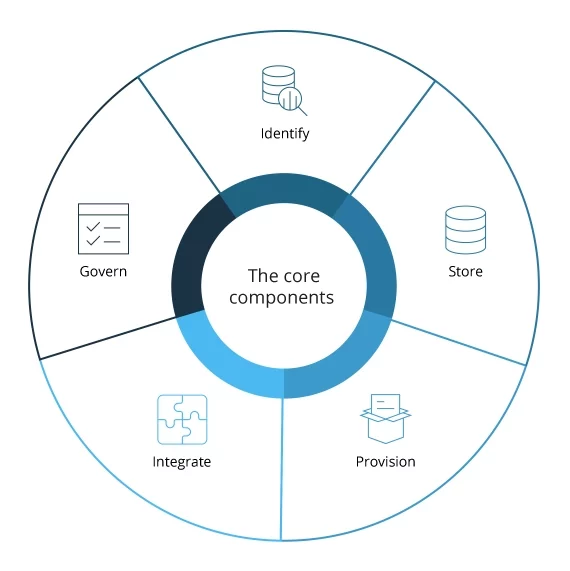The Ultimate Guide to Building a Successful Data Strategy in 2025
Table of Contents

In the present digital era, data is more than just numbers in spreadsheets; it is a major source of innovation, efficiency, and growth. For firms to thrive in this competitive environment, they must develop a data strategy in alignment with corporate goals that will maximize the value of these data assets.
An effective data strategy, therefore, enables organizations to maximize the potential of data-driven decision-making for better business decisions and customer experiences. With the onset of the year 2025, the need for a solid strategy for data cannot be emphasized enough.
Why a Data Strategy Matters Today
With data exploding on the back of various devices such as the Internet of Things, social media, cloud platforms, and enterprise systems, a uniform strategy for data becomes imperative to harmonize data collection, processing, and utilization. Businesses that do not build a strategy for data risk being overtaken by companies that work faster, with more sophisticated data capabilities.
The future-oriented strategy for data allows your organization to tap into Big Data Analytics, giving it insights in real time and decision-making capabilities that are more future-oriented. It allows responding faster to new trends in markets and evolving customer needs.
Elements of a Modern Data Strategy
A strategy for data becomes successful only when these multiple components work together to support business objectives. It is these pillars that make up a scalable, adaptable data strategy that withstands the test of time.

*Infopulse
1. Definite Business Objectives
From defining the rationale behind starting a data strategy, it works down to coming up with a clear definition of organizational goals: improve customer retention, enhance efficiency in operations, or launch new products. While strategy for data always stands on the broader mission, as well as on specific KPIs.
This alignment drives data-driven decision-making, where data is the primary input to make strategic and operational decisions. By linking your strategy for data to tangible results, your business can remain focused and effective.
2. Enterprise Data Management
Effective enterprise data management is the backbone on which every robust data strategy has been built. It refers to the processes of standardizing, integrating, and regulating the collection of data into departments so that its use, availability, and quality are all uniform.
A coherent strategy for data will call on maintaining and sustaining flow in systems without establishing barriers. Organizations that practice effective enterprise management of data always manage continuity at all times, promote collaborative working, and achieve operational excellence.
3. Data Governance Framework
The implementation of any good strategy for data hinges on effective data governance. It involves defining who gets access to an enterprise’s data and who has the rights to modify and manage it. It serves as the structured mechanism through which data quality, security, and compliance are achieved.
Data governance is important to set in a data strategy to keep your organization safe from data misuse, fines due to regulatory non-compliance, and reputational harm. Governance should keep pace with changes in your business and the regulatory landscape.
4. Scalable Architecture and Infrastructure
Your strategy for data should facilitate growth by leveraging scalable and flexible technology infrastructure. Cloud computing, data lakes, and new databases are critical for efficiently managing growing volumes of data.
With appropriate architecture, your strategy for data can support real-time processing and combine sophisticated tools for Big Data Analytics. This infrastructure makes sure that insights are produced at business speed, promoting responsiveness and innovation.
5. Emphasis on Data Quality
Data quality is non-negotiable for any credible strategy for data. Inaccurate or incomplete data may result in poor decisions and misallocations of resources. Setting standards for data accuracy, completeness, and timeliness is very important.
A thorough strategy for regularly auditing, validating, and cleansing data to ensure a high degree of data quality. High-quality data is the cornerstone of any successful data decision-making scenario, where one seeks to reduce risk and maximize rewards.
6. Advanced Analytics and Correlation with AI
Today, the strategy for data can only be said to be complete when it has incorporated big data analytics and artificial intelligence tools. They turn raw data into actionable intelligence and, therefore, predictive and prescriptive insights.
Your strategy for data must include tools for machine learning, natural language processing, and real-time analytics. But, above everything, Big Data Analytics brings improved decision-making while working beyond it into customer personalization and operational efficiency.
How to Create a Winning Data Strategy
Another component of your data strategy is creating a data strategy within the organization. This means encouraging teams to use data as part of their workflow and decision-making.
Your strategy for data must include training programs, explicit communication, and endorsement by leaders for a data decision-making mindset to flourish. A culture that makes data central brings in innovation and accountability.

*BeyondKey
Data Privacy, Ethics & Compliance
Above all, data must be held in trust; this gives birth to responsibilities regarding ethical and legal management of data. A sound strategy for data would provide for the implementation of measures warranted by data privacy laws such as GDPR, HIPAA, and other regional laws.
The ethical component(s) certainly play a role in a data strategy, e.g., algorithmic bias or covert surveillance systems. While transparency in data governance fosters stakeholder trust, it, in turn, minimizes legal risks.
Winning the Game of Your Data Strategy
In order to guarantee that your strategy for data produces results, you need to establish metrics for measuring progress and effect. Examples of these may be faster decision-making, decreasing costs, rising revenue, and customer satisfaction.
An effective strategy for data would thus continuously rewrite its approach to changing technological and business models. By constant assessment and refinement of the methods used, you can ensure success that lasts amid the best of a data-driven world.
Typical Challenges and Ways to Conquer Them
Building a strategy for data that works is not easy; commonplace difficulties include data silos, lack of leadership, less capacity, and legacy systems. All that needs careful planning, cross-functional collaboration, and continued refreshing of the last two.
It is important to note, however, that data strategies should not be static; they should also change in line with technology and organizational requirements. Open communications in such investments lead to longevity in enterprise management of data and analytics adoption.
Future Trends Shaping the Data Strategy Today
This year and beyond, several trends are emerging that completely change the way organizations formulate and implement their data strategy. It is the ability to predict and effectively align with such trends that gives them a competitive edge and flexibility.
1. Data Fabric and Mesh Architectures
With data governance at the forefront, data fabric and data mesh architectures are at the very basis of modern data strategy frameworks that support a decentralized approach to data management. These models are geared towards making data available more often and quickly, reducing bottlenecks.
They vastly impact scaling enterprise management of data with agility and responsiveness. Embedding these architectures will surely add resilience and future possibilities to any data strategy.
2. AI-Powered Data Management
AI is altering our perception of data management. From automated data classification to predictive governance, AI tools are making enterprise management of data ever smarter and more efficient.
By AI integration within the data strategy, you are removing manual activities, speeding up insights, and implementing a dynamic data decision-making approach. This trend is projected to grow impressively by the end of 2025.
3. Focus on Real-Time Analytics
Timeliness is of paramount importance in modern business. A future-oriented strategy for data has built the capability to perform real-time or near-real-time analytics to support agile response and proactive planning.
Thus, using Big Data Analytics in real time allows organizations to not only spot trends and anomalies but also seize opportunities as they arise.
4. Emphasis on Data Literacy
A viable strategy for data is not about know-how; it is about human beings. In 2025, data literacy will emerge as a must-have skill across departments. Equipping employees to accurately read and interpret data is crucial.
The strategy for data that builds in data literacy ensures the adoption and deeper insight beyond all levels of the organization, thus facilitating better data decision-making.
Accelerate your career with the Post Graduate Certificate Programme in Applied Data Science and AI at IIT Roorkee
Enroll in the Postgraduate Certificate Programme in Applied Data Science & AI at IIT Roorkee and gain cutting-edge skills from this prestigious institution in India. This programme aims to boost academic performance by combining data science and AI concepts with practical, real-life applications.
Here, Jaro Education plays a pivotal role in providing personalized one-on-one career counseling sessions, helping you choose the best course in line with your personal goals. A very comprehensive learning experience is ensured through this strategic partnership for future-ready professionals.
Conclusion
More than tools and technology, a winning strategy for data is about aligning data initiatives to business goals, empowering people, and retaining adaptability. From enterprise data management to data governance, each aspect of your data strategy must be holistic and deliberate.
While technology rapidly evolves and data volumes are exponentially growing, organizations with a well-grounded and forward-looking strategy for data will set the pace for innovation and impact. The ability to make timely, well-informed decisions based on data is no longer an option; it is a requisite.
Right now is the hour of evaluation, redesign, and strengthening of your strategy for data to face the demands of an ever-complex, data-driven environment. A pathway to business success starting in 2025 and beyond takes shape from a strategy centered on clarity, collaboration, and continuous improvement.
Frequently Asked Questions
How do you develop a data strategy?
In order to create a successful strategy for data, balance business objectives with data capabilities, establish firm data governance, and construct a technology, people, and process-supported roadmap for data decision-making.
What are the 5 essential components of a data strategy?
The five main elements are data architecture, enterprise data management, data governance, analytics capabilities such as big data analytics, and a data-driven culture to enable strategic decision-making.
What are KPI for data strategy?
KPIs for a data strategy are data accuracy rates, time to insights, speed of decision-making, adoption of data decision-making, and ROI from big data analytics initiatives.
What are the 6 dimensions of data quality?
Accuracy, completeness, consistency, timeliness, validity, and uniqueness are the six dimensions, and they are all important to sound enterprise management of data and a successful strategy for data implementation.
What is an example of a data strategy?
One such strategy for data is the use of big data analytics and data governance by a retail firm to monitor customer activity in real time and support data-driven decision-making in marketing and stock optimization.

















